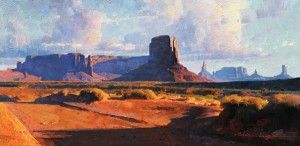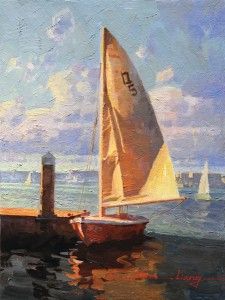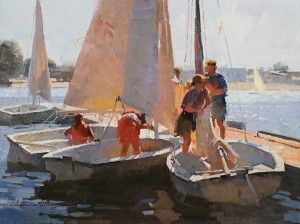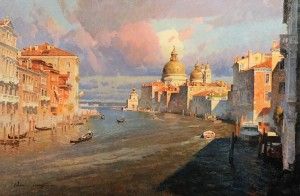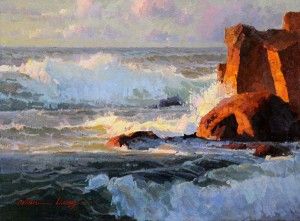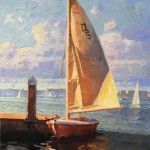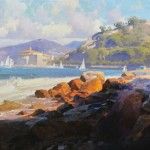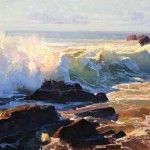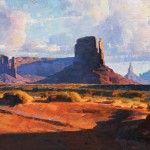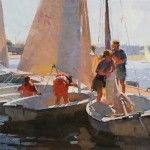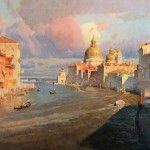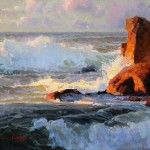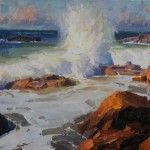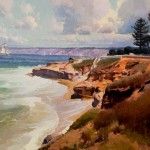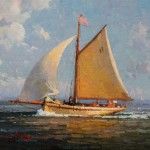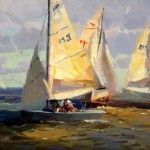Calvin Liang’s paintings share his joy for the natural world
By Norman Kolpas
This story was featured in the September 2014 issue of Southwest Art magazine. Get the Southwest Art September 2014 print issue or digital download now–then subscribe to Southwest Art and never miss another story!
“You could have a happy party, with dancing and singing, right here,” laughs Calvin Liang, while gazing upon his recently finished oil painting entitled LONG SHADOW.
At first glance, a viewer who has newly come upon the image might pause and wonder at the artist’s statement. A party? Certainly the work is undeniably lovely, the colorful scene impeccably executed in a style the artist chooses to describe as “painterly realism,” in which visible and often richly textured brush strokes depict a scene with believable precision. But the subject matter might not, at first, suggest the setting for a fun-filled get-together: a stretch of red-dirt road framed by scrub brush, backed by the majestic sandstone formations of Monument Valley in Utah.
Within moments, however, Liang’s optimistic point of view becomes clear. The interplay of light and shadows subtly frames a foreground space where people could, indeed, happily gather—a brightly illumined place that anyone would be happy to enter. The artist has fashioned an idyllic spot from which to view the glories of the natural world, a place where good friends would be welcome companions. Dancing and singing might well ensue.
The work is typical of Liang’s approach to the subjects he chooses to depict. He demonstrates mastery in every aspect of a work, from line and composition to light and shadow, color and values—as one might expect from a realist classically trained in top schools on both sides of the Pacific. And he possesses the ability to capture an unerring sense of place, and to draw viewers into the worlds he portrays—qualities not surprising in a man who spent a good portion of his early career specializing in scenic design for stage and screen.
Yet, there’s another very particular quality that can only derive not from schooling or work experience but simply from the man himself: a spirit of joy that radiates from every canvas. “Whenever I paint,” says Liang, “I think about the happy feelings I felt in the moment I first saw that scene. And then I try to convey those feelings to the viewer.”
Art and happiness have been intertwined in Liang’s life as far back as he can remember. “When I was 4 or 5 years old,” he recalls of his childhood in the mid-1960s in the Chinese city of Canton, “I was really in love with drawing. I would stay in my house for hours drawing cartoons with a pencil.”
That passion quickly transformed into his earliest vision of a future life as an artist. “When I was 7 or 8, I saw an artist with an easel painting a landscape in a park in our area. And I thought that one day I would get an easel and get to paint like that,” he says.
His parents soon nurtured that dream. Recognizing their son’s budding talent, they signed him up when he was 10 for Sunday drawing lessons with an artist friend of his father’s. He learned how to see and capture shapes, how to capture values, and other basics that “put me on the right track.” By the age of 13 or 14, he was steered toward watercolors and then into oil painting.
After high school, Liang was admitted to the training program for set designers at the prestigious Canton Opera Institute. Two years later, he was admitted to the advanced set-design program at the Shanghai Academy of Fine Art. Though his studies focused on the theater, he notes, “The training was the same as for traditional painting. We did still life, life drawing from models, landscapes, everything. Whether you’re painting a set design or a landscape or seascape, the basic elements are the same—shape, color, value, and edges. The only big difference is the scale.”
Having completed the program, Liang returned to a staff position as one of the principal designers at the Canton Opera. During his six years there, he completed the sets for three major operatic productions.
He still dreamed, however, of life as a painter. And during those years, he’d added another dream as well: coming to the United States. “In China, people see the works of Wyeth, Sargent, and Whistler in books,” he says. “But I really wanted to learn to paint like Sargent, and China was not really open at the time. I wanted to go to America to learn.”
After waiting a year and a half, in 1987 Liang finally received a student visa to study at San Francisco’s Academy of Art College (now the Academy of Art University). His two years there provided further opportunity to solidify the foundation of skills he’d developed in China. Even more, it afforded him the time to set down new American roots. He married, saw his parents and his brother immigrate as well, and in 1989, got his green card to stay in the U.S.
For a while, though, he felt as if his art career had stalled. “I could not find a good job,” he says, though he sold paintings through outdoor shows staged by the Artists Guild of San Francisco, in which he’d gained membership.
Finally, an opportunity came in a job that drew on his old professional skills, while offering a new area to explore. In 1997, a year after he’d attained U.S. citizenship, he was hired by Walt Disney Animation Studios and moved from the Bay Area to Burbank, where he worked on scenic backgrounds for a sequel to The Little Mermaid, which was released on video in 2000. Following that project, he went on to a job at Nickelodeon Studios as a background artist for the popular TV series SpongeBob SquarePants.
That almost six-year span was a satisfying and successful time for Liang, with work that brought him joy. “Even in the animation studio, I really loved to paint,” he says. Nevertheless, whenever he could, he also painted his own works, relishing the chance to express more fully his own creativity in oils. “In animation,” he explains, “you use acrylics and the computer, and you’ve got to follow the script and follow the director’s and art director’s ideas.” So, during evenings and weekends and while on vacation, he’d take to his easel and palette to capture the seascapes, sailboats, rocky shores, landscapes, and even street scenes that brought him surpassing pleasure.
Starting in 2000, he began to be offered solo shows at top galleries, and sales of his works steadily increased. By 2002, he had shows of his works scheduled through 2004, so he bid Nickelodeon and SpongeBob adieu and launched himself on a full-time fine-art career.
Liang, now 54 and living with his wife and their teenage son in the Southern California town of Corona, has continued happily on that path for the past decade, painting almost daily in the 430-square-foot studio he has fashioned from a bedroom and den in the family’s two-story, four-bedroom home.
He still paints the scenes he has long loved, for shows that have been known to sell out completely on opening night. Now, though, after years of executing many of his works en plein air, he has transitioned to larger canvases, like his 28-by-60-inch CATALINA ISLAND, his own “artistic vision” of the Southern California coastal getaway, which he calls “my favorite place to paint.” Painting on such a scale demands more time than an outdoor session would allow, so he’ll typically base such works on quick on-location charcoal and color studies, which he combines with extensive digital reference photos in executing the finished work.
In that piece, as in his other works, Liang manages to conjure an irresistible sense of place, deploying all the skills he has honed through his education and work background to draw the viewer into a setting that he uncannily suffuses with beauty, peace, and contentment. “I want you to feel like you can take a deep breath, feel the atmosphere, and enjoy the scene like you’re right there,” he says.
Liang plans to plunge his growing audience of collectors into still more locations as he continues to expand his explorations of the world. In VENICE, for example, he celebrates a place that once fascinated him from the pages of magazine articles and which he has visited several times since his first trip in 2006. “Oh my goodness!” he exclaims. “Every angle in Venice was a painting. I couldn’t believe it. I try to capture the wind, the clouds, the sky, the movement, and to show how light is the major player in the painting.”
Recently, he has begun to explore more American western subjects like his Monument Valley work and some desert scenes. He’s also been doing a lot of life drawing and even thinking of including cowboys and Indians in some future paintings.
Whatever the subject, however, Liang has one paramount goal in mind. “In my studio, I’m really trying to enjoy the painting,” he says. “And the thought that the people who collect that painting and hang it on their wall will be enjoying it, too—what an amazing idea for me!”
representation
InSight Gallery, Fredericksburg, TX; Sage Creek Gallery, Santa Fe, NM; Trailside Galleries, Scottsdale, AZ.
Featured in the September 2014 issue of Southwest Art magazine–click below to purchase:
Southwest Art September 2014 print issue or digital download Or subscribe to Southwest Art and never miss a story!
- Calvin Liang, Breeze, Newport Beach, oil, 12 x 9.
- Calvin Liang, Catalina Island, oil, 28 x 60.
- Calvin Liang, Incoming Tide, Cambria, oil, 12 x 16.
- Calvin Liang, Long Shadow, oil, 15 x 30.
- Calvin Liang, Setting sails in Newport Beach, oil, 12 x 16.
- Calvin Liang, Venice, oil, 24 x 36.
- Calvin Liang, Carmel Waves, oil, 12 x 16.
- Calvin Liang, Incoming Tide, Laguna Beach, oil, 9 x 12.
- Calvin Liang, La Jolla Cove, San Diego, oil, 24 x 36.
- Calvin Liang, Sailing Along, oil, 12 x 16.
- Calvin Liang, Sailing for Fun, oil, 12 x 16.
MORE RESOURCES FOR ART COLLECTORS & ENTHUSIASTS
• Subscribe to Southwest Art magazine
• Learn how to paint & how to draw with downloads, books, videos & more from North Light Shop
• Sign up for your Southwest Art email newsletter & download a FREE ebook






